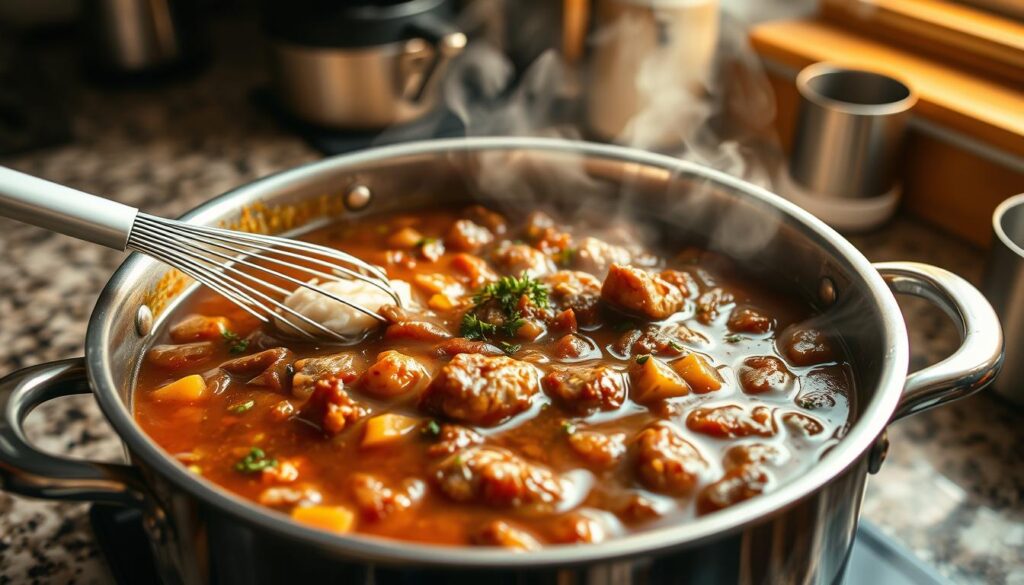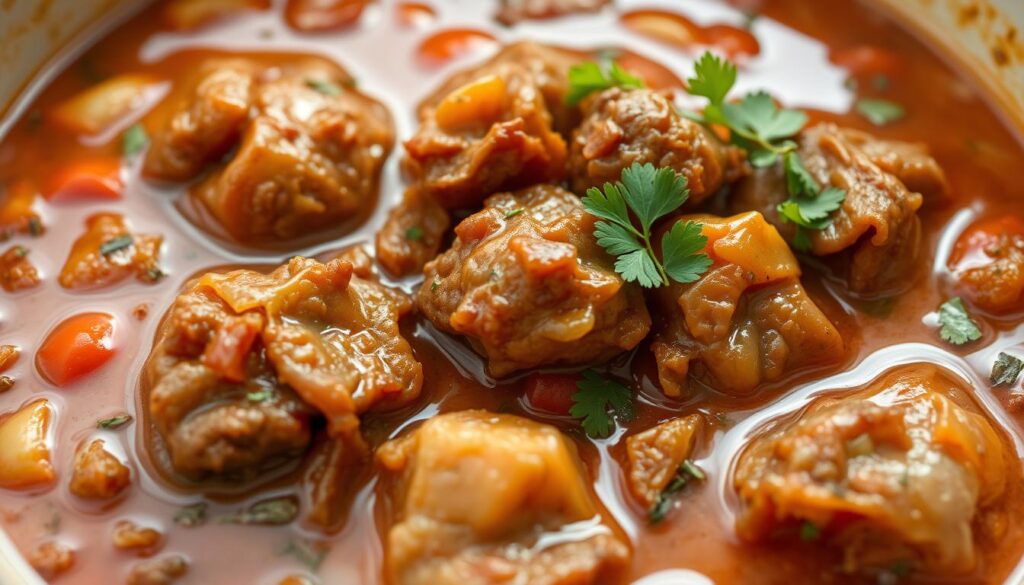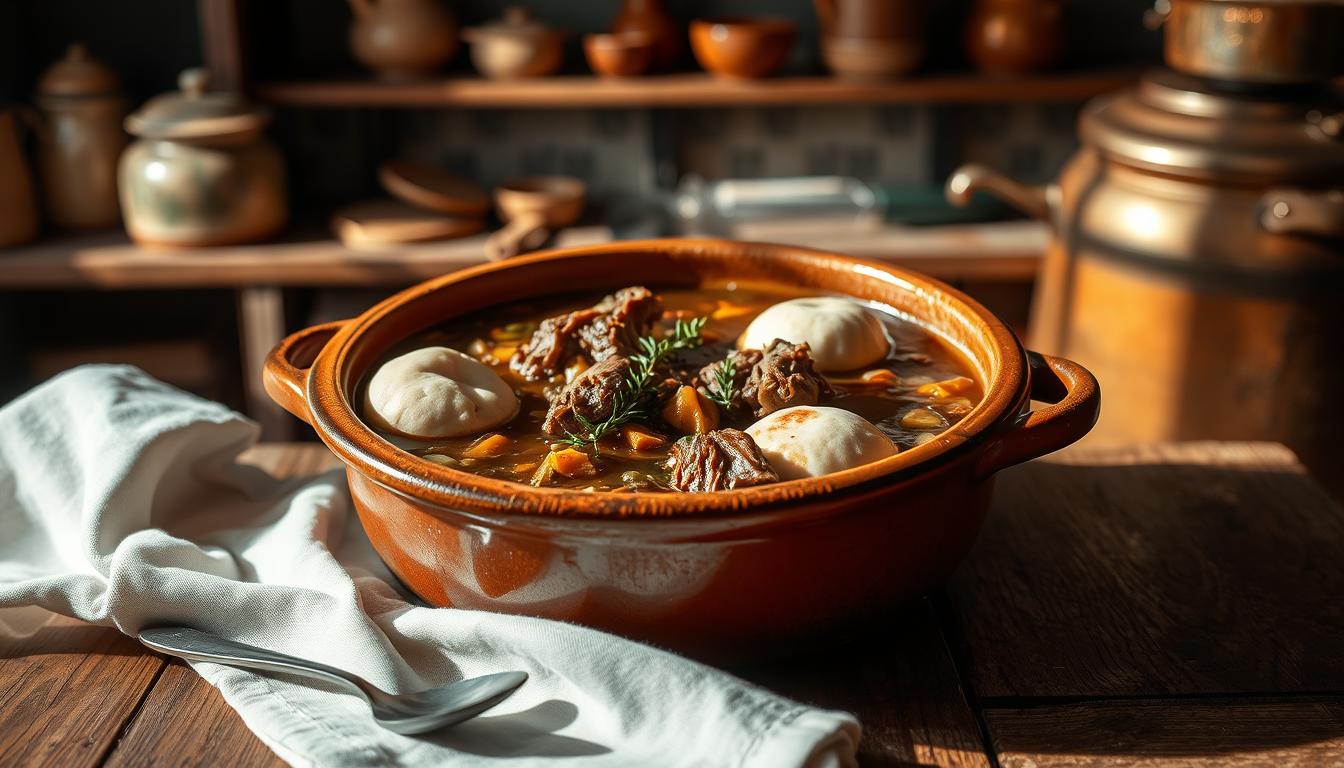There’s something deeply comforting about a hearty dish that reminds you of home. For many, the aroma of spices like cinnamon, cardamom, and ginger simmering with tender pieces of meat brings back cherished memories of family gatherings. This mutton stew recipe is inspired by those nostalgic flavors, offering a taste of tradition with every bite.
Whether you’re cooking for a special occasion or simply craving a warm, flavorful meal, this dish is versatile and easy to personalize. You’ll learn two effective methods to thicken your stew, ensuring it has the perfect consistency every time. From using a pressure cooker to slow simmering, these techniques will elevate your cooking game.
With ingredients like onion, garlic, and a blend of spices, this recipe is packed with rich, savory flavors. It’s a dish that invites you to experiment, making it uniquely yours. Let’s dive into the steps and tips to create a meal that’s both satisfying and memorable.
Key Takeaways
- Learn two simple methods to thicken your stew for the perfect texture.
- Discover how traditional spices like cinnamon and cardamom enhance the flavor.
- Explore the benefits of using a pressure cooker or slow simmering techniques.
- Personalize the dish with ingredient adjustments to suit your taste.
- Enjoy a hearty meal that brings the warmth of home-cooked traditions to your table.
Getting Started with Your Mutton Stew Recipe
The foundation of any great dish lies in the quality of its components. Whether you’re a seasoned cook or a beginner, selecting the right ingredients and tools can make all the difference. Let’s explore how to prepare a flavorful meal that brings warmth and tradition to your table.
Ingredient Selection and Preparation
Start with high-quality mutton, preferably from a trusted source. Fresh vegetables like carrots, potatoes, and onion add depth to the dish. Dice them evenly for consistent cooking. Spices such as cardamom, cinnamon, garlic, and ginger are essential for an authentic flavor profile. Use a tablespoon of oil to sauté the spices, enhancing their aroma.
When it comes to seasoning, balance is key. A pinch of salt and a dash of pepper can elevate the taste without overpowering the dish. Remember, cooking is as much about intuition as it is about precision. As one traditional cook once said,
“Measure with your heart, not just your tools.”
Essential Tools and Techniques for Home Cooking
Having the right tools can simplify the process. A pressure cooker is ideal for tenderizing meat quickly, while a crockpot allows for slow, even cooking. Both methods have their merits, depending on your time and preference. For example, the Bannur sheep breed, known for its tender meat, has been a staple in traditional dishes for over 500 years1.
Don’t stress over exact measurements. Many home cooks rely on memory and intuition, adding a cup of water or a handful of spices as needed. This approach not only saves time but also adds a personal touch to your cooking. Embrace the charm of less conventional techniques and let your creativity shine.
Two Proven Techniques to Thicken Your Stew
Achieving the perfect consistency for your dish can elevate it from good to exceptional. Whether you prefer a silky texture or a hearty broth, these two methods will help you master the art of thickening.

Using Cornflour and Alternative Flour Slurries
One of the simplest ways to thicken your dish is by using a cornflour slurry. Mix one tablespoon of cornflour with two tablespoons of cold water until smooth. Gradually stir this mixture into your simmering broth, and watch it transform into a rich, velvety texture in just a few minutes.
If you don’t have cornflour, alternatives like rice flour or maida work just as well. These flours are perfect for achieving a silky consistency without altering the flavor. Remember to cook the mixture for at least 2-3 minutes to remove any raw taste2.
Vegetable Reduction and Mashing Methods
For a natural thickening method, try vegetable reduction. Simmer your dish until the liquid reduces, concentrating the flavors. Adding starchy vegetables like potatoes can also help. Simply mash cooked potatoes and stir them into the broth for a creamy, thick texture.
This method not only enhances the consistency but also boosts the nutritional value. It’s a great way to use leftover vegetables and reduce food waste. For best results, cook the potatoes for 15-20 minutes until tender2.
Both techniques are easy to apply and can be tailored to your preferences. Try them out and discover which one suits your taste and texture goals.
Mutton Stew Recipe: Tips for Authentic Flavor and Perfect Consistency
Mastering the art of flavor and texture can turn a simple dish into a culinary masterpiece. Whether you’re a seasoned cook or a beginner, these tips will help you create a rich and authentic meal that’s both satisfying and memorable.

Enhancing Taste with Spices and Coconut Milk
Spices are the heart of any flavorful dish. A blend of cardamom, cinnamon, garlic, and ginger can elevate the taste profile. For a creamy texture, add a cup of coconut milk. First-pressed coconut milk offers a richer flavor, while second-pressed is lighter3.
Tempering with ghee and fried onion adds depth. Heat a tablespoon of ghee, fry the onions until golden, and mix them into your dish. This technique enhances the aroma and richness4.
Pressure Cooking versus Crockpot Methods
Choosing the right cooking method can make a big difference. A pressure cooker locks in flavors and reduces cooking time significantly. Cook for about 20-25 minutes for tender results3.
On the other hand, a crockpot allows for slow simmering, which enhances the depth of flavors. Cook on low heat for 6-8 hours for a melt-in-your-mouth texture. Both methods have their merits, so choose based on your schedule and preference4.
- Balance salt, pepper, and spice powder for a well-rounded curry flavor.
- Add starchy vegetables like potatoes in the last hour of cooking for a thicker consistency.
- Skim off excess fat during cooking for a cleaner, richer broth.
These tips will help you create a dish that’s both authentic and perfectly thickened. Experiment with flavors and techniques to make it uniquely yours.
For best results, cook the potatoes for 15-20 minutes until tender3. This method not only enhances the consistency but also boosts the nutritional value.
Conclusion
Creating a rich, flavorful dish is all about balancing tradition with personal creativity. By using a cornflour slurry or vegetable reduction, you can achieve the perfect consistency for your meal. These methods are simple yet effective, ensuring a hearty texture every time5.
Start with fresh ingredients like onion, cardamom, and a pinch of pepper to build depth. A cup of coconut milk adds creaminess, while proper pressure cooking or slow simmering enhances tenderness6.
Don’t be afraid to experiment. Adjust the spice levels or add your favorite vegetables to make the dish uniquely yours. Once you’ve perfected it, share your creation with friends and family. Your personal touch can turn a classic into something extraordinary.
With these tips and techniques, you’re ready to craft a dish that’s both comforting and delicious. Enjoy the process, and let your creativity shine in every bite.

